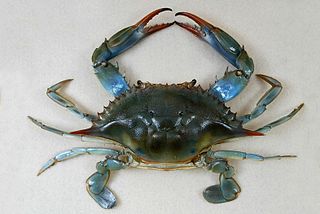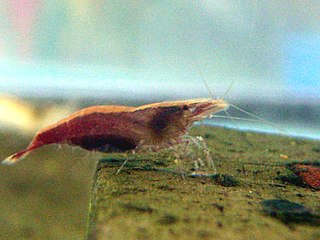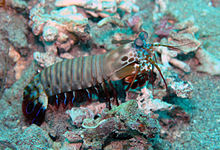
The Grey Cup is both the championship game of the Canadian Football League (CFL) and the trophy awarded to the victorious team playing in the namesake championship of professional Canadian football. The game is contested between the winners of the CFL's East and West Divisional playoffs and is one of Canadian television's largest annual sporting events. Since 2022, the game was held on the third Sunday of November. The Toronto Argonauts have the most Grey Cup wins (19) since its introduction in 1909, while the Edmonton Elks have the most Grey Cup wins (11) since the merger in 1958. The latest, the 111th Grey Cup, took place in Vancouver, British Columbia, on November 17, 2024, when the Toronto Argonauts defeated the Winnipeg Blue Bombers 41-24.

Mantis shrimp are carnivorous marine crustaceans of the order Stomatopoda. Stomatopods branched off from other members of the class Malacostraca around 400 million years ago. Mantis shrimp typically grow to around 10 cm (3.9 in) in length, while a few can reach up to 38 cm (15 in). A mantis shrimp's carapace covers only the rear part of the head and the first four segments of the thorax. Varieties range in colour from shades of brown to vivid colours, with more than 520 species of mantis shrimp known. They are among the most important predators in many shallow, tropical and subtropical marine habitats. However, despite being common, they are poorly understood, as many species spend most of their lives sheltering in burrows and holes.

Malacostraca is the second largest of the six classes of pancrustaceans behind insects, containing about 40,000 living species, divided among 16 orders. Its members, the malacostracans, display a great diversity of body forms and include crabs, lobsters, crayfish, shrimp, krill, prawns, woodlice, amphipods, mantis shrimp, tongue-eating lice and many other less familiar animals. They are abundant in all marine environments and have colonised freshwater and terrestrial habitats. They are segmented animals, united by a common body plan comprising 20 body segments, and divided into a head, thorax, and abdomen.

Eucarida is a superorder of the Malacostraca, a class of the crustacean subphylum, comprising the decapods, krill, and Angustidontida. They are characterised by having the carapace fused to all thoracic segments, and by the possession of stalked eyes.
William Thomas Calman was a Scottish zoologist, specialising in the Crustacea. From 1927 to 1936 he was Keeper of Zoology at the British Museum.

Phyllocarida is a subclass of crustaceans, comprising the extant order Leptostraca and the extinct orders Hymenostraca and Archaeostraca. This clade of marine crustaceans diversified extensively during the Ordovician.

Eumalacostraca is a subclass of crustaceans, containing almost all living malacostracans, or about 40,000 described species. The remaining subclasses are the Phyllocarida and possibly the Hoplocarida. Eumalacostracans have 19 segments. This arrangement is known as the "caridoid facies", a term coined by William Thomas Calman in 1909. The thoracic limbs are jointed and used for swimming or walking. The common ancestor is thought to have had a carapace, and most living species possess one, but it has been lost in some subgroups.
Hippolyte bifidirostris is a chameleon shrimp of the family Hippolytidae, found around New Zealand at depths of 18–36 metres (59–118 ft). It may also occur on Australia's Great Barrier Reef, but that record may need to be confirmed.

Palaemonidae is a family of shrimp in the order Decapoda. Many species are carnivores that eat small invertebrates, and can be found in any aquatic habitat except the deep sea. One significant genus is Macrobrachium, which contains commercially fished species. Others inhabit coral reefs, where they associate with certain invertebrates, such as sponges, cnidarians, mollusks, and echinoderms, as cleaner shrimps, parasites, or commensals. They generally feed on detritus, though some are carnivores and hunt tiny animals.

Caridina serratirostris is a species of freshwater shrimp that lives in the Indo-west Pacific region, from Madagascar to Fiji, including northern Queensland, Australia, which may be a different subspecies. Its common name in the aquarium trade, "ninja shrimp", comes from its ability to quickly change colour and disappear into its surroundings like a ninja. Adults grow to a length of 25–35 millimetres (1.0–1.4 in).

Kallidecthes is an extinct genus of crustaceans.
Aeschronectida is an extinct order of mantis shrimp-like crustaceans which lived in the Mississippian subperiod in what is now Montana. They exclusively lived in the Carboniferous, or the age of amphibians. They have been found mostly in the U.S. and in the British Isles, in 1979 species were found in the Madera Formation in New Mexico. Aeschronectida was first identified appearing in Continental Europe in around 2014. While sharing similar characteristics to Stomatopoda, they lack certain physical characteristics of that taxon. The first species of Aeschronectida is accredited to Frederick R. Schram. They diverge substantially from typical hoplocaridan morphology by having more unmodified thoracopods. It's theorized that these thoracopods evolved to become more specialized, making them potential ancestors to Stomatopoda.
Kellibrooksia is an extinct genus of crustacean in the order Hoplostraca from the Middle Pennsylvanian.

Alope is a genus of shrimp in the family Hippolytidae, comprising two species:
Phylogeny of Malacostraca is the evolutionary relationships of the largest of the six classes of crustaceans, containing about 40,000 living species, divided among 16 orders. Its members display a great diversity of body forms. Although the class Malacostraca is united by a number of well-defined and documented features, which were recognised a century ago by William Thomas Calman in 1904, the phylogenetic relationship of the orders which compose this class is unclear due to the vast diversity present in their morphology. Molecular studies have attempted to infer the phylogeny of this clade, resulting in phylogenies which have a limited amount of morphological support. To resolve a well-supported eumalacostracan phylogeny and obtain a robust tree, it will be necessary to look beyond the most commonly utilized sources of data.

Hymenodora is a genus of shrimp, containing four species, which collectively have a southern circumpolar distribution.

Dorphinaxius kermadecensis is a species of mud lobster native to the Norfolk Island, parts of New South Wales, and the Kermadec Islands of New Zealand. It is the only species in the genus Dorphinaxius. It has a depth range of 0–8 metres (0–26 ft).

Crustaceans are invertebrate animals that constitute one group of arthropods that are a part of the subphylum Crustacea, a large, diverse group of mainly aquatic arthropods including decapods, seed shrimp, branchiopods, fish lice, krill, remipedes, isopods, barnacles, copepods, opossum shrimps, amphipods and mantis shrimp. The crustacean group can be treated as a subphylum under the clade Mandibulata. It is now well accepted that the hexapods emerged deep in the Crustacean group, with the completed pan-group referred to as Pancrustacea. The three classes Cephalocarida, Branchiopoda and Remipedia are more closely related to the hexapods than they are to any of the other crustaceans.

The clade Multicrustacea constitutes the largest superclass of crustaceans, containing approximately four-fifths of all described non-hexapod crustacean species, including crabs, lobsters, crayfish, shrimp, krill, prawns, woodlice, barnacles, copepods, amphipods, mantis shrimp and others. The largest branch of multicrustacea is the class Malacostraca.

Acanthosquilla derijardi is a species of stomatopod crustacean. Its distribution is widespread throughout the Indo-West Pacific. The species was initially described by the American carcinologist Raymond B. Manning in 1970. Its junior synonym, A. sirindhorn, was named in 1995 in honor of Princess Sirindhorn of Thailand.
















